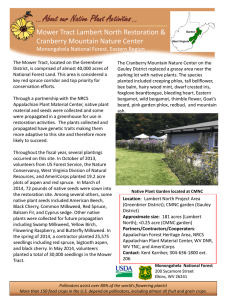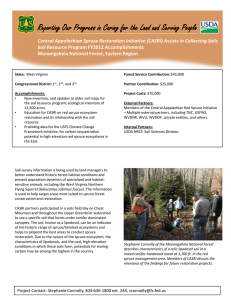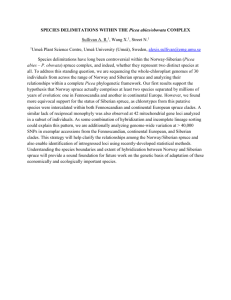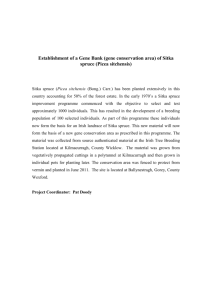Document 11863915
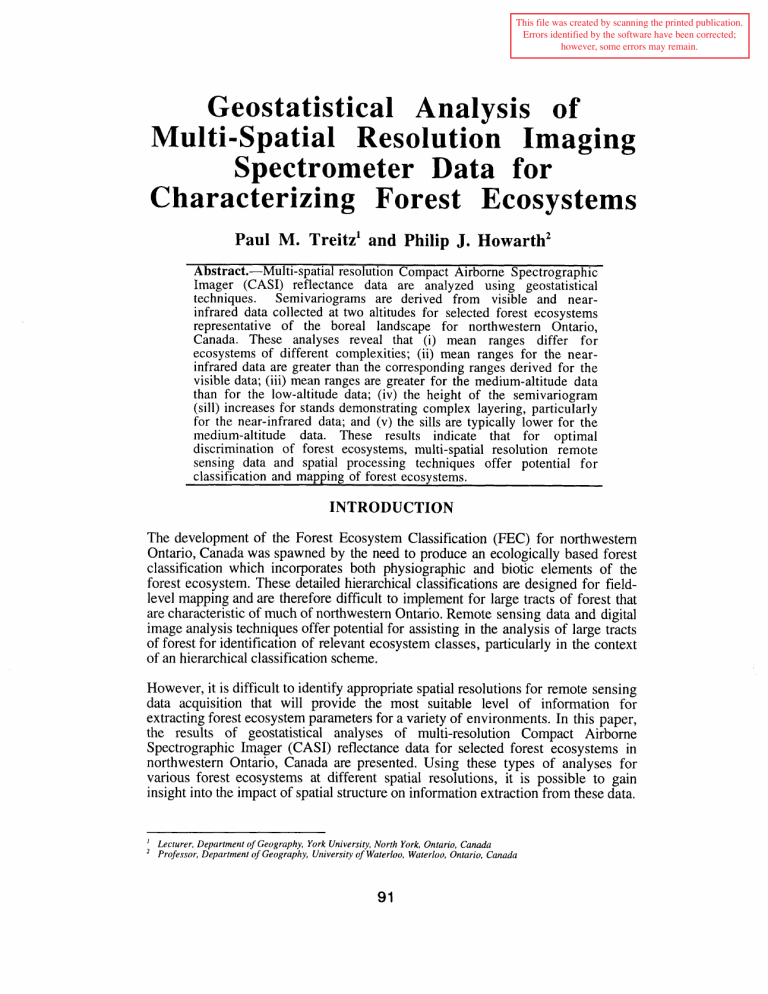
This file was created by scanning the printed publication.
Errors identified by the software have been corrected; however, some errors may remain.
Geostatistical Analysis
of
Multi-Spatial Resolution Imaging
-
Spectrometer Data for characterizing Forest Ecosystems
Paul
M.
Treitzl
and
Philip J. Howarth2
Abstract.-Multi-spatial resolution Compact Airborne Spectrographic
Imager (CASI) reflectance data are analyzed using geostatistical techniques. Semivariograms are derived from visible and near- infrared data collected at two altitudes for selected forest ecosystems representative of the boreal landscape for northwestern Ontario,
Canada. These analyses reveal that (i) mean ranges differ for ecosystems of different complexities; (ii) mean ranges for the near- infrared data are greater than the corresponding ranges derived for the visible data; (iii) mean ranges are greater for the medium-altitude data than for the low-altitude data; (iv) the height of the semivariogram
(sill) increases for stands demonstrating complex layering, particularly for the near-infrared data; and (v) the sills are typically lower for the medium-altitude data. These results indicate that for optimal discrimination of forest ecosystems, multi-spatial resolution remote sensing data and spatial processing techniques offer potential for classification and mapping of forest ecosystems.
INTRODUCTION
The development of the Forest Ecosystem Classification (FEC) for northwestern
Ontario, Canada was spawned by the need to produce an ecologically based forest classification which incorporates both physiographic and biotic elements of the forest ecosystem. These detailed hierarchical classifications are designed for field- level mapping and are therefore difficult to implement for large tracts of forest that are characteristic of much of northwestern Ontario. Remote sensing data and digital image analysis techniques offer potential for assisting in the analysis of large tracts of forest for identification of relevant ecosystem classes, particularly in the context of an hierarchical classification scheme.
However, it is difficult to identify appropriate spatial resolutions for remote sensing data acquisition that will provide the most suitable level of information for extracting forest ecosystem parameters for a variety of environments. In this paper, the results of geostatistical analyses of multi-resolution Compact Airborne
Spectrographic Imager (CASI) reflectance data for selected forest ecosystems in northwestern Ontario, Canada are presented. Using these types of analyses for various forest ecosystems at different spatial resolutions, it is possible to gain insight into the impact of spatial structure on information extraction from these data.
'
Lecturer, Department of Geography, York University, North York, Ontario, Canada
Professor, Department of Geography, University of Waterloo, Waterloo, Ontario, Canada
GEOSTATISTICAL ANALYSIS OF
REMOTE SENSING
DATA
Jupp et al. (1988) describe many remote sensing scenes as spatial arrangements of two- or three- dimensional objects superimposed on a uniform background. In this scenario, they consider a discrete object scene model as an appropriate abstraction of the scene. In this model, one or more classes of objects can be described by a unique set of properties or parameters. This abstraction is appropriate for certain applications of remote sensing and digital image analysis. However, within a forest ecosystem context, not only does the canopy structure vary with ecosystem type, but the background can also vary significantly with respect to composition and structure.
The brightness values of a remotely sensed image are a function of spatial position during image acquisition. In the realm of geostatistics, these brightness values can therefore be considered as values of a "regionalized variable" (Matheron, 1963). To apply regionalized variable theory to the analysis of remotely sensed data, adoption of a stochastic view of the landscape and its spatial structure is required (Jupp et al.,
1988). This is a logical assumption since underlying processes and properties of the landscape will produce many similar scenes. In fact, this is intrinsic to the classification of ecosystems. It is assumed that similar ecosystems will arise from similar environmental conditions and processes linked closely to landscape. In this study, semivariogram analysis is used to examine the spatial structure of high resolution CASI data collected for natural forest ecosystems, characteristic of northwestern Ontario.
Semivariogram Analysis
The semivariogram, which originates from the theory of regionalized variables developed by Matheron (1963), is used to measure the spatial dependence of neighboring observations for any continuously varying phenomenon. Hence, it is a technique that can be applied to spectral data, a variable for which position in space and time is known. In this manner, spatial variation in images can be examined in relation to ground scene and sensor parameters (Woodcock et al., 1988).
The semivariogram plots semivariance against spatial separation along a given relative o r i e n t a h and ~rovides pattern of spatial calculated as: variibility (Curran, 1988). The sedvariogram or y(h) is where h is the lag (or distance) over which y (semivariance) is measured, n is the number of observations used in the estimate of y(h), and Z is the value of the variable of interest at spatial position xi . + h) is the variable value at distance h from xi. In this study, y(h) estimates the variability of reflectance, 2, as a function of spatial separation.
The sernivariogram has proven useful in remote sensing because it enables researchers to relate some of the descriptors of the semivariogram to the spatial characteristics of the scene. For example, the range, which defines the distance at which pixels are not spatially related, provides a measure of the size of the elements in the scene and has been suggested as a useful indicator in selecting the optimal spatial resolution for discriminating the features embedded in the image semivariogram (Curran, 1988). Woodcock et al. (1988) also found that the density of coverage of objects in the scene affects the height of the semivariogram.
Atkinson and Danson (1988) used semivariograms to measure spatial dependence in coniferous and oak plantations. They found the range of the semivariogram was related to stand age and species, and were able to determine the optimal spatial resolutions for even-aged stands. Cohen et al. (1990) found the ranges for lm spatial resolution data were related to the mean tree canopy sizes of the stands.
STUDY AREA
The study area is located within the Central Plateau section of the Boreal Forest
Region (Rowe, 1972) approximately 100 km north of Thunder Bay, Ontario,
Canada. A diverse mosaic of forest stand types with various soil and landform conditions resulting from glacial activities are characteristic of the area. This area represents a low- to moderate-relief boreal environment with a rolling topography and terrain controlled by bedrock. Trembling aspen (Populus tremuloides) and black spruce (Picea mariana) are dominant with jack pine (Pinus banksiana), white spruce (Picea glauca), balsam fir (Abies balsamea), white birch (Betula papyrifera), white cedar (Thuja occidentalis) and tamarack (Lark laricina) occurring in various mixtures. Forest-stand overstories are monospecific or mixed and understories range from shrub- andlor herb-rich to poor.
The FEC that is applied in the study area is the Northwestern Ontario (NWO) FEC
(Sims et aL, 1989). The framework upon which FECs are based incorporates those components of forest site which contribute to forest development (i.e., canopy and understory vegetation, soils, landform, climatic regime, and regional physiography)
(Sims and Uhlig, 1992). FECs were developed for stand-level (i.e., <I: 10,000) application to provide information regarding vegetation, soil and site conditions.
The basic units of FECs are 'Vegetation Types' (V-Types) and 'Soil Types' (Sims et al., 1989). Since FECs are hierarchical, field-level units can be aggregated to create lower-resolution ecosystem units (Hills and Pierpoint, 1960).
METHODS
Remote Sensing Data Acquisition
CASI data were acquired over the study site on July 30, 1993. These data were collected at approximately 10:30 a.m. along a flight line oriented parallel to the solar azimuth in order to minimize the effects of bidirectional reflectance (BDRF). A nine-band multispectral dataset was collected at two different altitudes with spatial resolutions of 1.39m x 5.36m (figures 1 and 2); and 0.73m x 5.36m (figures 3 and
4). The CASI data were converted to radiance and then to reflectance using procedures outlined in Babey and Soffer (1992) and Shepherd (1994).
Semivariance Analysis of Multi-Spatial Resolution
Remote Sensing Data
In this study, experimental semivariograms are used to model the underlying sernivariogram for the CASI reflectance data. A single visible band and a near- infrared band were used for calculating semivariance and deriving semivariograms from low- and medium-altitude CASI data. Homogeneous stands (landscape units) of sufficient size were identified on aerial photographs and located on the low- and medium-altitude CASI images. To examine the spatial variability of forest ecosystems at high spatial resolutions, transects of 100 pixels in the cross-track direction were extracted from the CASI data for selected forest stands representing individual V-Types or complexes of V-Types (table I). These stands are arranged in the table and in the corresponding figures along a gradient of pure hardwood to pure conifer. These visible and near-infrared data were subjected to semivariogram analysis' to estimate range and sill values using a spherical model. A series of transects were analyzed for each forest stand, from which the mean ranges and sills were calculated to characterize the stand / landscape unit.
Figure 1.-Medium-altitude data Figure 2.-Medium-altitude data
Figure 3.-Low-altitude data Figure 4.-Low-altitude data
Geostatistical software: VARIOWIN (V.2.1) developed by Y. Pannatier at the Institute of Mineralogy of the University of Lausanne SWITZERLAND (PANNATIER, Y .,l994. MS-WINDOWS for Exploratory Variography and Variogram
A~pllcatlons. Capasso, V., Girone G. and
Posa, D. Eds., Bari, Italy, Sep. 27-30, 1993 pp. 165-170).
Table 1.-Forest ecosystem groupings for semivariogram analysis
Forest Ecosystem V-Types (defined by Sims et al., 1989)
Grouping
Aspen
Aspen Complex
Aspen Mixedwood
V5 Aspen Hardwood
V6 Trembling Aspen (W. Birch) - Balsam Fir / Mountain Maple
V8 Trembling Aspen (W. Birch) / Mountain Maple
V9 Balsam Fir - White Spruce Conifer and Mixedwood
V10 Trembling Aspen
V l 1 Trembling Aspen
- Black Spruce - Jack Pine / Low Shrub
- Conifer / Blueberry / Feathermoss
V8 Trembling Aspen (White Birch) / Mountain Maple
V11 Trembling Aspen - Conifer / Blueberry / Feathermoss
V19 Black Spruce Mixedwood / Herb Rich
Conifer Mixedwood V8 Trembling Aspen (White Birch) / Mountain Maple
V 14 Balsam Fir Mixedwood
V 15 White Spruce Mixedwood
V16 Balsam Fir - White Spruce Mixedwood / Feathermoss
V19 Black Spruce Mixedwood 1 Herb Rich
Eastern White Cedar V22 Eastern White Cedar
Upland Black Spruce V33 Black Spruce I Feathermoss
Black Spruce Mix V33 Black Spruce / Feathermoss
V34 Black Spruce I Labrador Tea / Feathermoss (Sphagnum)
V35 Black Spruce / Speckled Alder / Sphagnum
V36 Black Spruce I Bunchberry I Sphagnum (Feathermoss)
Lowland Black Spruce V35 Black Spruce / Speckled Alder / Sphagnum
V36 Black Spruce I Bunchberry / Sphagnum (Feathermoss)
V37 Black Spruce I Ericaceous Shrub / Sphagnum
Wetland Black Spruce V37 Black Spruce / Ericaceous Shrub / Sphagnum
V38 Black Spruce / Leatherleaf / Sphagnum
RESULTS
At the low altitude, and for the stands sampled, the mean ranges derived from the semivariograms for the visible band indicate that trembling aspen stands have greater ranges (z 8 pixels / 5.8m) ) than upland black spruce stands
(Z
6 pixels /
4.4m) and lowland black spruce stands
(E
4 pixels I 2.9m) (figure 5). In general, the range values for the visible band increase with stand complexity. A similar trend is observed with respect to the range values for the near-infrared data whereby hardwood and conifer mixedwood stands have greater ranges than lowland black spruce. For example, range values are approximately 10 pixels I 7.3m for aspen complexes; 1 1 pixels I 8.0m for conifer mixedwood; 9 pixels 1 6.6m for upland black spruce; and 6 pixels I4.4m for lowland black spruce. The ranges derived for the near-infrared data are generally greater than those derived for the visible data for each ecosystem class (e.g., 6 pixels I 4.4m (infrared) versus 4 pixels 1 2.9m
(visible) for lowland black spruce). The sills for the trembling aspen and conifer mixedwood stands are much greater than those of the lowland black spruce stands, particularly for the near-infrared data. For example, the mean near-infrared semivariance (sill) is approximately 1700 for aspen stands; 2200 for conifer mixedwood stands; and 350 for lowland black spruce stands (figure 6). Although the trend is similar in the visible band, the differences are not as extreme.
0 0
For the medium-altitude data, the differences in mean ranges between the aspen stands and the lowland black spruce stands for the near-infrared data are not as pronounced. However, the ranges for the near-infrared data are greater than those for the visible data for all stands, particularly lowland black spruce (i.e., 7 pixels /
9.7m versus 3.5 pixels I 4.9m). Ranges derived from the medium-altitude data are greater than those measured for the low-altitude data. For example, the mean ranges for the trembling aspen stands are approximately 7.5 pixels / 5.5m for the low- altitude data while for the medium-altitude data they are approximately 6.5 pixels /
9.0m. Finally, the sills are typically lower for the medium-altitude data in comparison to the low-altitude data.
CONCLUSIONS
For the low-altitude CASI data, the hardwood and mixed conifer stands have greater range values than pure conifer, particularly lowland conifer where canopy and understory are generally simple and homogeneous. At this resolution, individual trees may be the dominant feature affecting the semivariogram, particularly for the black spruce and trembling aspen stands since the crown diameters of these species are approximately equal to the ranges of influence.
However, since these pixels are not square and individual trees are not observable, it is more likely that the ranges of influence are determined by an integration of a uniform number of tree crowns with understory and ground cover components.
The contrasting ranges of the near-infrared and visible data indicate that different featuredphenomena are being measured in the near infrared as opposed to the visible, or at least the proportional contributions of featuredphenomena to reflectance differ between these data. It is likely that the near-infrared data contain more ground-cover information since near-infrared energy has greater potential for penetration through a forest canopy. The differences in the range values observed at each spatial resolution for the same ecosystems reveals that information content also differs at the two altitudes. This observation would indicate that different featuredphenomena or aggregations of featuredphenomena (e. g., possibly 2-3 tree crowns with associated understories) are being measured at the medium resolution.
The observed differences in the magnitude of semivariance at both resolutions indicates that the trembling aspen stands (pure and mixed) and conifer mixedwood stands have increased layering with a greater volume of total cover than the black spruce stands. The complexity of the stand is more prevalent with the near-infrared data, since near-infrared energy has a greater capability of interacting with understory components. The occurrence of lower sills for the medium-altitude data indicates increased regularization as a result of decreased variability of forest stand reflectance at this resolution.
Based on these observations, it is anticipated that the potential for identifying forest ecosystems at a variety of levels will be improved by applying spatial analysis techniques (e.g., texture processing, spatial interpolation) to multi-spatial resolution remote sensing data. The identification of a single optimal spatial resolution for forest ecosystem discrimination may not be possible. Instead, it may be more suitable to analyze multi-spatial resolution data with appropriate processing techniques to extract various scales of information.
ACKNOWLEDGMENTS
Funding for this project has been provided through the Northern Ontario
Development Agreement, Northern Forestry Program. Additional support has been provided by a Center of Excellence Grant from the Province of Ontario to the
Institute for Space and Terrestrial Science.
REFERENCES
Atkinson, P. and Danson, F. 1988. Spatial resolution for remote sensing of forest plantations, IGARSS188 Symposium, Edinburgh, Scotland, ESA Publications
Division, pp. 22 1-223.
Babey, S. and Soffer, R. 1992. Radiometric calibration of the Compact Airborne
Spectrographic Imager (CASI), Canadian Journal of Remote Sensing,
18(4):233-242.
Curran, P. J. 1988. The semivariogram in remote sensing: an introduction, Remote
Sensing of Environment, 24: 493-507.
Hills, G. and Pierpoint, G. 1960. Forest site evaluation in Ontario, Research
Report No. 42, Ontario Department of Lands and Forests, Toronto, Ontario,
Canada, 63 pp.
Jupp, D.L.B., Strahler, A.H. and Woodcock, C.E. 1988. Autocorrelation and regularization in digital images: I. basic theory, IEEE Transactions on
Geoscience and Remote Sensing, 26(4):463-473.
Matheron, G. 1963. Principles of geostatistics, Economic Geology 58: 1246- 1266.
Rowe, J. 1972. Forest Regions of Canada, Publication No. 1300, Canadian
Forestry Service, Department of the Environment, Ottawa, Ontario, Canada,
172 pp.
Shepherd, P. 1994. Section 3.3, Airborne Remote Sensing Data, in Kalnins, V.,
Treitz P. and Howarth, P., Rinker Lake Data Report: 1993-1994, Earth-
Observations Laboratory, Technical Report ISTS-EOL-TR94-002, pp. 19-48.
Sims, R. and Uhlig, P. 1992. The current status of forest site classification in
Ontario, The Forestry Chronicle, 68(1): 64-77.
Sims, R., Towill, W., Baldwin, K. and Wickware, G. 1989. Field Guide to Forest
Ecosystem Classification for Northwestern Ontario, Ontario Ministry of Natural
Resources, Toronto, Ontario, Canada, 19 1 pp.
Woodcock, C.E., Strahler, A.H. and Jupp, D.L.B. 1988. The use of variograms in remote sensing: I. scene models and simulated images, Remote Sensing of
Environment, 25:323-348.
BIOGRAPHICAL SKETCH
Paul Treitz is a Lecturer in the Department of Geography (Faculty of Arts) and
Faculty of Environmental Studies at York University, North York, Ontario,
Canada. He is also a Ph.D. student in the Department of Geography at the
University of Waterloo, Waterloo, Ontario, Canada.
Philip Howarth is a Professor of Geography at the University of Waterloo,
Waterloo, Ontario, Canada. He is also a Principal Investigator with the Earth-
Observations Laboratory of the Institute for Space and Terrestrial Science, a center of excellence established by the Province of Ontario for remote sensing and space related research.

